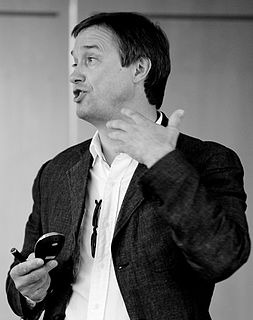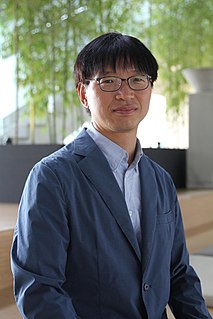Related Research Articles

Spectroscopy is the study of the interaction between matter and electromagnetic radiation as a function of the wavelength or frequency of the radiation. In simpler terms, spectroscopy is the precise study of color as generalized from visible light to all bands of the electromagnetic spectrum; indeed, historically, spectroscopy originated as the study of the wavelength dependence of the absorption by gas phase matter of visible light dispersed by a prism. Matter waves and acoustic waves can also be considered forms of radiative energy, and recently gravitational waves have been associated with a spectral signature in the context of the Laser Interferometer Gravitational-Wave Observatory (LIGO).
Atomic, molecular, and optical physics (AMO) is the study of matter-matter and light-matter interactions; at the scale of one or a few atoms and energy scales around several electron volts. The three areas are closely interrelated. AMO theory includes classical, semi-classical and quantum treatments. Typically, the theory and applications of emission, absorption, scattering of electromagnetic radiation (light) from excited atoms and molecules, analysis of spectroscopy, generation of lasers and masers, and the optical properties of matter in general, fall into these categories.
Quantum optics is a branch of atomic, molecular, and optical physics dealing with how individual quanta of light, known as photons, interact with atoms and molecules. It includes the study of the particle-like properties of photons. Photons have been used to test many of the counter-intuitive predictions of quantum mechanics, such as entanglement and teleportation, and are a useful resource for quantum information processing.

Grigory Samuilovich Landsberg was a Soviet physicist who worked in the fields of optics and spectroscopy. Together with Leonid Mandelstam he co-discoverer inelastic combinatorial scattering of light, which known as Raman scattering.

Roy Jay Glauber was an American theoretical physicist. He was the Mallinckrodt Professor of Physics at Harvard University and Adjunct Professor of Optical Sciences at the University of Arizona. Born in New York City, he was awarded one half of the 2005 Nobel Prize in Physics "for his contribution to the quantum theory of optical coherence", with the other half shared by John L. Hall and Theodor W. Hänsch. In this work, published in 1963, he created a model for photodetection and explained the fundamental characteristics of different types of light, such as laser light and light from light bulbs. His theories are widely used in the field of quantum optics. In statistical physics he pioneered the study of the dynamics of first-order phase transitions, since he first defined and investigated the stochastic dynamics of an Ising model in a largely influential paper published in 1963. He served on the National Advisory Board of the Center for Arms Control and Non-Proliferation, the research arms of Council for a Livable World.

Theodor Wolfgang Hänsch is a German physicist. He received one fourth of the 2005 Nobel Prize in Physics for "contributions to the development of laser-based precision spectroscopy, including the optical frequency comb technique", sharing the prize with John L. Hall and Roy J. Glauber.

Daniel Frank Walls FRS was a New Zealand theoretical physicist specialising in quantum optics.

Sir Peter Leonard Knight is a British physicist, professor of quantum optics and senior research investigator at Imperial College London, and principal of the Kavli Royal Society International Centre. He is a leading academic in the field of quantum optics and is the recipient of several major awards including the Royal Medal from the Royal Society and the Thomas Young Medal and Prize from the Institute of Physics. He is a former president of the Institute of Physics and the Optical Society of America, the first non North American-based person to take the position.

The Max-Planck-Institute for Quantum Optics is a part of the Max Planck Society which operates 87 research facilities in Germany.

Vladimir (Vlad) M. Shalaev is a Distinguished Professor of Electrical and Computer Engineering and Scientific Director for Nanophotonics at Birck Nanotechnology Center, Purdue University.
Robert Alfano is an Italian-American experimental physicist. He is a Distinguished Professor of Science and Engineering at the City College and Graduate School of New York of the City University of New York, where he is also the founding Director of the Institute for Ultrafast Spectroscopy and Lasers (1982). He is a pioneer in the fields of Biomedical Imaging and Spectroscopy, Ultrafast lasers and optics, tunable lasers, semiconductor materials and devices, optical materials, biophysics, nonlinear optics and photonics; he has also worked extensively in nanotechnology and coherent backscattering. His discovery of the white-light supercontinuum laser is at the root of optical coherence tomography, which is breaking barriers in ophthalmology, cardiology, and oral cancer detection among other applications. He initiated the field known now as Optical Biopsy

Mihai Gavrilă is a Romanian quantum physicist and a corresponding member of the Romanian Academy since 1974. He made fundamental contributions to the quantum theories of electromagnetic interactions with atoms.

Robert William Boyd is an American physicist noted for his work in optical physics and especially in nonlinear optics. He is currently the Canada Excellence Research Chair Laureate in Quantum Nonlinear Optics based at the University of Ottawa, Professor of Physics cross-appointed to the School of Electrical Engineering and Computer Science at the University of Ottawa, and Professor of Optics and Professor of Physics at the University of Rochester.
Quantum-optical spectroscopy is a quantum-optical generalization of laser spectroscopy where matter is excited and probed with a sequence of laser pulses.
Mikhail Lukin ; born 10 October 1971) is a Russian theoretical and experimental physicist and a professor at Harvard University. He was elected a member of the National Academy of Sciences in 2018.
Eric Jakeman is a British mathematical physicist specialising in the statistics and quantum statistics of waves. He is an Emeritus Professor at the University of Nottingham.

(James) Roy Taylor is Professor of Ultrafast Physics and Technology at Imperial College London.

Howard John Carmichael is a British-born New Zealand theoretical physicist specialising in quantum optics and the theory of open quantum systems. He is the Dan Walls Professor of Physics at the University of Auckland and a principal investigator of the Dodd-Walls Centre. Carmichael has played a role in the development of the field of quantum optics and is particularly known for his Quantum Trajectory Theory (QTT) which offers a more detailed view of quantum behaviour by making predictions of single events happening to individual quantum systems. Carmichael works with experimental groups around the world to apply QTT to experiments on single quantum systems, including those contributing to the development of quantum computers. He is a Fellow of Optical Society of America, the American Physical Society and the Royal Society of New Zealand. He was awarded the Max Born Award in 2003, the Humboldt Research Award in 1997 and the Dan Walls Medal of the New Zealand Institute of Physics in 2017. In 2015, he was recognised as an Outstanding Referee by the American Physical Society.

Choi Wonshik is an optical physicist researching deep-tissue imaging and imaging through scattering media. He is a full professor in the Department of Physics of Korea University where he serves as the associate director at the IBS Center for Molecular Spectroscopy and Dynamics. Inside the Center, he leads the Super-depth Imaging Lab. He has been cited more than 4,000 times and has an h-index of 32. He is a fellow of The Optical Society.

Debabrata Goswami FInstP FRSC, is an Indian chemist and the Prof. S. Sampath Chair Professor of Chemistry, at the Indian Institute of Technology Kanpur. He is also a Professor of The Department of Chemistry and The Center for Lasers & Photonics at the same Institute. Goswami is an associate editor of the open-access journal Science Advances. He is also an Academic Editor for PLOS One and PeerJ Chemistry. He has contributed to the theory of Quantum Computing as well as nonlinear optical spectroscopy. His work is documented in more than 200 research publications. He is an elected Fellow of the Royal Society of Chemistry, Fellow of the Institute of Physics, the SPIE, and The Optical Society. He is also a Senior Member of the IEEE, has been awarded a Swarnajayanti Fellowship for Chemical Sciences, and has held a Wellcome Trust Senior Research Fellowship. He is the third Indian to be awarded the International Commission for Optics Galileo Galilei Medal for excellence in optics.
References
- 1 2 3 "Edward Roy Pike". Debrett's People of Today. Retrieved 12 December 2013.
- ↑ "Company Overview of Phonologica Ltd: Edward Roy Pike FRS". Bloomberg. Retrieved 12 December 2013.
- ↑ "Faraday medal recipients". Institute of Physics website. Retrieved 8 January 2014.
- ↑ Lewis, John L (1999). 125 Years: The Physical Society & The Institute of Physics. CRC Press. p. 155. ISBN 9780750306096.
- ↑ Parry, Gareth (1975). "Photon Correlation and Light Beating Spectroscopy". Optica Acta. 22 (12): 1045. doi:10.1080/713819001.
- ↑ Vojta, G. "E. R. Pike, L. A. Lugiato (eds). Chaos, noise and fractals. Malvern physics series", Crystal Research and Technology - CRYST RES TECH 01/1988; 23(9):1120-1120. DOI:10.1002/crat.2170230913